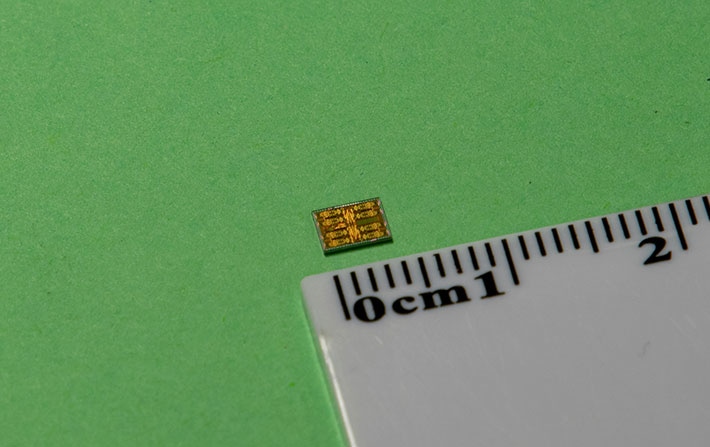Feb 19 2019
A 28 GHz transceiver built by scientists at Tokyo Tech incorporates beamforming with dual-polarized multiple-input and multiple-output (MIMO) technology. Measuring only 3 mm by 4 mm, this miniature transceiver could help enhance performances of Internet of Things (IoT) devices and fifth-generation cellular network (5G).
 The new transceiver measures only 3 mm x 4 mm. The proposed chip, fabricated in a standard 65-nm CMOS process, takes up a total area of just 12 mm2. (Image credit: Tokyo Institute of Technology)
The new transceiver measures only 3 mm x 4 mm. The proposed chip, fabricated in a standard 65-nm CMOS process, takes up a total area of just 12 mm2. (Image credit: Tokyo Institute of Technology)
A team of scientists led by Kenichi Okada at Tokyo Tech’s Department of Electrical and Electronic Engineering has formulated a plan with a clear focus on supporting high-speed mobile data access using the millimeter-wave spectrum for 5G, the highly-awaited wireless network of the near future.
Their planned 28-GHz transceiver integrates beamforming, a highly efficient signal processing technique, with dual-polarized MIMO capabilities, meaning that its array of antennas can react to both vertical and horizontal radio waves simultaneously.
Initial testing revealed that the maximum data rate accomplished was 15 gigabits per second (GB/second) in the 64-QAM format. This data rate is 25% more than that realized by earlier comparable models.
As a follow-up of Okada and his group’s work on developing high-level transceivers using few components, the scientists completed a design that fits into an area measuring just 3 mm by 4 mm, which is about half the size accomplished to date. The tinier the chip, the better for 5G, on account of the projected demand for high-performance, area-efficient transceivers for use in miniature and portable devices and sensors.
“Compared with the conventional switch-based bi-directional approach, our bi-directional amplifier completely shares the inter-stage matching networks between the transceiver and the receiver. Thus, the required on-chip area is further minimized,” Okada explains.
Japan is presently gearing up to prepare for 5G ahead of the Tokyo 2020 Olympic and Paralympic Games. There are huge hopes for 5G services to facilitate higher data throughput for applications such as live-streaming high-definition (HD) video and for possibly trillions of new IoT devices that can share data day and night, as well as to boost the speed and responsiveness of communication networks on the whole.
The study was partly supported by SCOPE, an initiative led by Japan’s Ministry of Internal Affairs and Communications that concentrates on endorsing advances in information and communication technologies.
Additional details of the research are being showcased as part of the 4G/5G Transceivers Session at the 2019 International Solid-State Circuits Conferenceouter (ISSCC) to be held in San Francisco between February 17th and 21st, 2019.